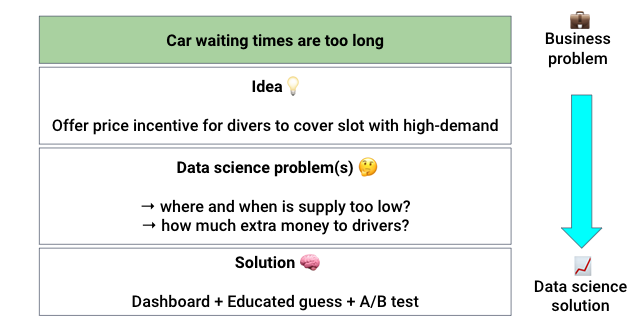
The one skill every professional data scientist must have? 🤔
Don't look for it in online courses, it's not there.
Read the thread below and find out ↓↓↓
Don't look for it in online courses, it's not there.
Read the thread below and find out ↓↓↓
In the real world, data science projects start from a business problem.
They are born to move a key business metric (KPI):
And you, as a data scientist, need to
1 → Understand the business problem
2 → Transform the business problem into a data science problem
3 → Solve it
They are born to move a key business metric (KPI):
And you, as a data scientist, need to
1 → Understand the business problem
2 → Transform the business problem into a data science problem
3 → Solve it

To transform a business problem into *the right* data science problem you
1 → ask questions and gather business context.
2 → explore the data to find clues.
There is nothing more frustrating than building a great data science solution... to the wrong business problem.
1 → ask questions and gather business context.
2 → explore the data to find clues.
There is nothing more frustrating than building a great data science solution... to the wrong business problem.
#Example: Let's say you work at Uber as a data scientist 🧑🏽🔬
And your product lead tells you:
👩💼: "We want to decrease user churn by 5% this quarter"
How do you go about solving this?...
And your product lead tells you:
👩💼: "We want to decrease user churn by 5% this quarter"
How do you go about solving this?...
There are different reasons why a user would stop using Uber.
For example:
1 → "Lyft offers better prices" 💸 → pricing problem
2 → "Car waiting times are too long" 🕑 → supply problem
3 → "The Android version of the app is very slow" 🐢 → App performance problem.
For example:
1 → "Lyft offers better prices" 💸 → pricing problem
2 → "Car waiting times are too long" 🕑 → supply problem
3 → "The Android version of the app is very slow" 🐢 → App performance problem.

You build this list by asking the rest of the team the right questions.
You need to understand the user's experience using the app, from HER point of view.
You need to understand the user's experience using the app, from HER point of view.
There is often no single reason behind churn, but a combination of them.
The question is: which one should you focus on? 🤔
This is when you pull out your great data science skills and EXPLORE THE DATA 🔎
The question is: which one should you focus on? 🤔
This is when you pull out your great data science skills and EXPLORE THE DATA 🔎
You explore the data to understand how plausible each of the above explanations is.
The output from this analysis is a single hypothesis you should consider further.
Depending on the hypothesis, you will solve the data science problem differently.
For example...
The output from this analysis is a single hypothesis you should consider further.
Depending on the hypothesis, you will solve the data science problem differently.
For example...
#Example 1: "Lyft offers better prices" 💸 (pricing problem)
Solution: Detect the segment of users who are likely to churn ( using an ML Model) and send personalized discounts via push notifications.
A/B test the discount to maximize impact without cannibalizing revenue.
Boom.
Solution: Detect the segment of users who are likely to churn ( using an ML Model) and send personalized discounts via push notifications.
A/B test the discount to maximize impact without cannibalizing revenue.
Boom.

#Example 2: "Car waiting times are too long" 🕑 (supply problem)
Solution: Identify the location and time where supply is low, and offer a price incentive for divers to cover these slots.
A good dashboard does the job, and an A/B test finds the optimal incentive.
Boom.
Solution: Identify the location and time where supply is low, and offer a price incentive for divers to cover these slots.
A good dashboard does the job, and an A/B test finds the optimal incentive.
Boom.

#Example 3: "The Android version of the app is very slow" 🐢 (App performance problem)
Solution: Go to the frontend devs, and show them the breakdown of memory usage by app version...
Solution: Go to the frontend devs, and show them the breakdown of memory usage by app version...

To sum up,
→ Translating a business problem into *the right" data science problem is (more than) half the job.
→ Ask the right questions, list possible solutions, and explore the data to narrow down the list to one.
→ Solve this one data science problem.
→ Translating a business problem into *the right" data science problem is (more than) half the job.
→ Ask the right questions, list possible solutions, and explore the data to narrow down the list to one.
→ Solve this one data science problem.
Every week I share real-world Data Science/Machine Learning content.
Follow me @paulabartabajo_ so you do not miss what's coming next.
Wanna help?
Like/Retweet the first tweet below to spread the wisdom
↓↓↓
Follow me @paulabartabajo_ so you do not miss what's coming next.
Wanna help?
Like/Retweet the first tweet below to spread the wisdom
↓↓↓
https://twitter.com/paulabartabajo_/status/1588184294903582720
• • •
Missing some Tweet in this thread? You can try to
force a refresh









